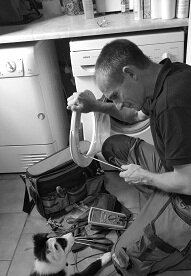Clean your exchanger
Once a month.
Clean filters
Every time you use the tumble dryer.
Tumble Dryer Maintenance
Regular maintenance will help to keep your appliance fault free
Vented and condenser dryers:
Remove and clean the fluff filter. This filter can usually be found at the front, just inside the door (see picture above).
Dispose of the loose fibres. For a thorough clean, use a vacuum cleaner nozzle to clean the cavity in which the filter sits.
Condenser dryers only:
If you have a condenser dryer it is important to remove fluff from the heat exchanger. This is usually found behind a cover at the bottom of the machine. Remove the unit and rinse it out under the tap or with a shower head once a month, or more frequently if the dryer is used more than a few times a week.
Condenser dryers have a container to collect the condensed water. Many dryers will not operate if this container is full. A vented dryer vents the condensed water out of a tube and is usually connected to the outside of the property.
Tumble dryers are more efficient if the clothes have space to move freely in the drum. Note the kilogram load capacity of your washing machine compared to your dryer. If you have an 8kg washing machine and a 6kg tumble dryer a full wash load will be more than the recommended dryer load. Always pay attention to care labels.
Appliances vary in design so we suggest downloading the user manual for specific instructions on cleaning and maintaining your dryer.
Want to see more tips then see our FAQs
How a Tumble Dryer Works: Unveiling the Inner Components
Hey there! So, you're curious about how a tumble dryer works, huh? Well, you've come to the right place! Let's dive in and explore the inner workings of this helpful appliance.
1. Drum: At the heart of every tumble dryer lies the drum, also known as the rotating cylinder. This is where you toss in your wet clothes for them to be dried. The drum is usually perforated, allowing warm air to circulate through the fabric, aiding the drying process.
2. Heating Element: Meet the heating element, the powerhouse behind drying efficiency. This element, typically made of metal or coil, heats up when activated. As the drum rotates, warm air generated by the heating element is circulated inside, evaporating the moisture from your clothes.
3. Blower Fan: Operating in harmony with the heating element is the blower fan. This component ensures proper air circulation within the dryer. By drawing in ambient air, it passes it through the heating element, warming it up, and then blows this warm air into the drum, expediting the drying process.
4. Thermostat: Don't worry; your clothes won't be baked to a crisp! Thanks to a handy device called the thermostat. Part of the dryer's safety mechanisms, it constantly monitors the temperature inside the drum. If it detects temperatures exceeding a certain threshold, it automatically shuts off the heating element, preventing overheating.
5. Timer: Time is of the essence! That's where the timer comes into play. You set it to determine the duration of the drying cycle. As the timer counts down, it communicates with various components, telling them when to start or stop their operations. It ensures that your garments are dried for the amount of time you desire.
6. Control Panel: Not to be overlooked, the control panel is the interface that grants you control over the entire drying process. Here, you can adjust various settings, such as temperature, timer, and specific drying modes (if available), enabling you to tailor the drying cycle to suit your needs.
7. Belt and Motor: Powering the drum's rotation is a belt and motor combo. As the motor runs, it spins the drum, allowing your clothes to tumble inside. This movement ensures that the warm air reaches every part of the fabric, eliminating moisture effectively.
8. Lint Filter: Last but not least


